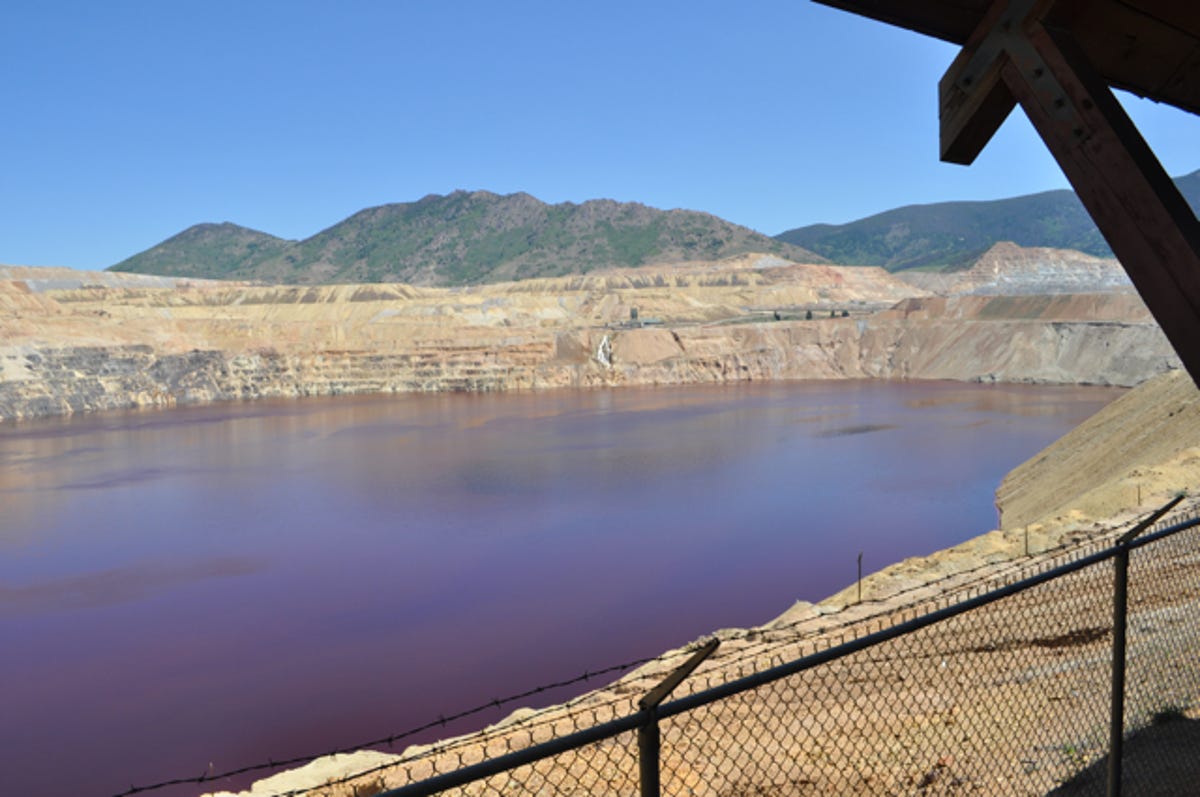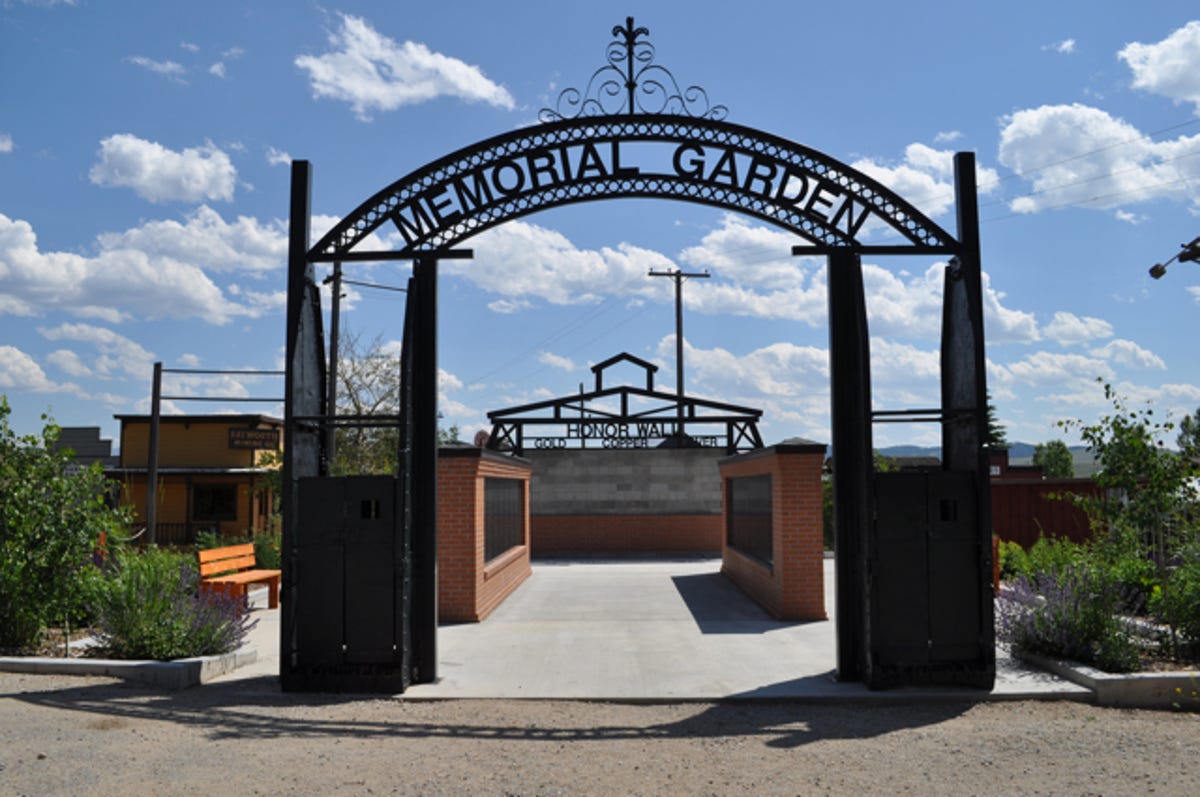Photos: Mining's domination of the 'richest hill on earth'
Once home to the world's most valuable mining property, Butte, Mont., now hosts America's biggest Superfund site. CNET Road Trip 2009 stopped in to see how mining can almost kill a boomtown.<br>

Berkeley Pit
Shown is the Berkeley Pit, the centerpiece of America's biggest Superfund site, the massive mining operations and their contamination of vast areas of northern Butte, Mont.
Once upon a time, Butte was the "richest hill on earth," producing the most wealth of any mining town in the world. But as groundwater rose up through the thousands of miles of mine shafts and a mammoth open pit mine, and metal contaminants spread throughout the area, the city's aquifer became endangered and the city faced extinction.
These days, the government and mining operators say they have things under some kind of control, but not all residents agree.
CNET News reporter Daniel Terdiman visited Butte on Road Trip 2009 to get a look at the riches and the incredible damage that come from giant mining operations.
Click here for the entire Road Trip 2009 package.
The mine and the house
Mining operations and the town of Butte were so intertwined that in several places, mines, and their giant headframes, are just about on top of people's houses.
These days, with the vast riches that once came to Butte from its mining production no longer flowing in, the historic district of town feels like a ghost town, with block after block after block of rundown, dilapidated houses and a sense that no one is around anymore.
Click here for the entire Road Trip 2009 package.
The Original
Copper mining got its start in earnest in Butte in 1878 with the construction of this first copper mine. Drilled down to a depth of 3,569 feet, the mine was in operation until 1940.
Over the years, the mine was responsible for 43 deaths.
Click here for the entire Road Trip 2009 package.
Middle of Berkeley Pit
It is said that the Berkeley Pit, which is more than 5,600 feet wide, 7,000 feet long, and 1,800 feet deep, is visible from the moon.
Click here for the entire Road Trip 2009 package.
Water treatment plant
To keep the rapidly rising water level from destroying Butte's aquifer--which would have essentially killed the town--the conglomerates in charge of the Berkeley Pit built a water treatment plant that pumps in water and uses it for mining operations.
While the waters are still rising--from groundwater coming up through the many mine tunnels underneath--the hope is that it can be kept below the critical water line until at least 2023.
Notice that the runoff from the treatment plant is white.
Click here for the entire Road Trip 2009 package.
Contintental Pit
While the Berkeley Pit is no longer operational, and is considered a massively contaminated site, the Continental Pit, which is just southeast of the Berkeley Pit, is fully functional and is still turning out copper ore every day.
Click here for the entire Road Trip 2009 package.
Entrance to Berkeley Pit viewing area
These days, the Berkeley Pit is a museum of sorts, allowing the public to see firsthand the side effects of incredible industrial operations like the mining that went on there. This is the entryway to the viewing area.
Click here for the entire Road Trip 2009 package.
Berkeley Pit and Continental Pit from higher ground
A view down at both the Berkeley Pit (in the foreground) and the Continental Pit, as seen from higher ground in Butte.
Click here for the entire Road Trip 2009 package.
Berkeley Pit and Continental Pit from higher ground
The Mountain Consolidated, or "Mt. Con" mine, in Butte, Mont. It is said to be a "mile high and a mile deep."
Click here for the entire Road Trip 2009 package.
Overhead map of mines
A map that shows the entire mining operations of Butte, Mont.
Click here for the entire Road Trip 2009 package.
Mining Truck returning
While the Berkeley Pit has long since been shut down, open pit mining is still going on in Butte. Here, a giant mining truck returns from a run, as seen from a long ways away.
Click here for the entire Road Trip 2009 package.
Alice Pit
Shown is the Alice Pit, in Butte, Mont., which was in operation from 1955 until 1960. It grew to be 750 feet wide, 1,300 feet long, and 290 feet deep.
Click here for the entire Road Trip 2009 package.
Hillside of mines
In Butte, it's not uncommon to look up and see a hillside dominated by the headframes of former mining operations.
Click here for the entire Road Trip 2009 package.
Yankee Doodle
While most of the attention in Butte's cleanup operations is focused on the Berkeley Pit, some feel no one is paying attention to the Yankee Doodle Tailings Pond, north of town, which also features extremely high concentrations of metal.
Click here for the entire Road Trip 2009 package.
Old Lexington Stamp Mil
The Old Lexington Stamp Mill, in Butte, Mont. Today the centerpiece of an exhibit on the town's mining history, it once produced $45 million worth of silver and gold ore.
A stamp mill--this one had 10 900-pound stamps--would crush rock into fine sand, from which the metals could be sifted.
Click here for the entire Road Trip 2009 package.
Rock Drill
One of the central pieces to any visitor's examination of Butte's mining history is the town's World Museum of Mining.
The museum is on the site of a formerly operational mining operation called the Orphan Girl.
The museum features the original headframe, as well as many of the components that made up the mine, which ran from 1875 until 1956, and produced 7.5 million ounces of silver.
This is a rock drill used to pound the rock far below the surface.
Click here for the entire Road Trip 2009 package.
The cage
This cage was used to ferry miners thousands of feet below the surface. The cage would be sent down at speeds of hundreds of feet per minute, meaning that it would take as little as five minutes to go 4,000 feet down.
Click here for the entire Road Trip 2009 package.
Mine Disaster
In 1917, a massive mine fire killed 168 miners trapped underground at the Granite Mountain site. Today, a memorial to those lost in the disaster is in place at the top of the hill in Butte.
Click here for the entire Road Trip 2009 package.

Memorial Garden
At the World Museum of Mining, there is also a memorial garden, which pays homage to the hundreds of miners who perished during the decades that Butte was the "richest hill on earth."
Click here for the entire Road Trip 2009 package.